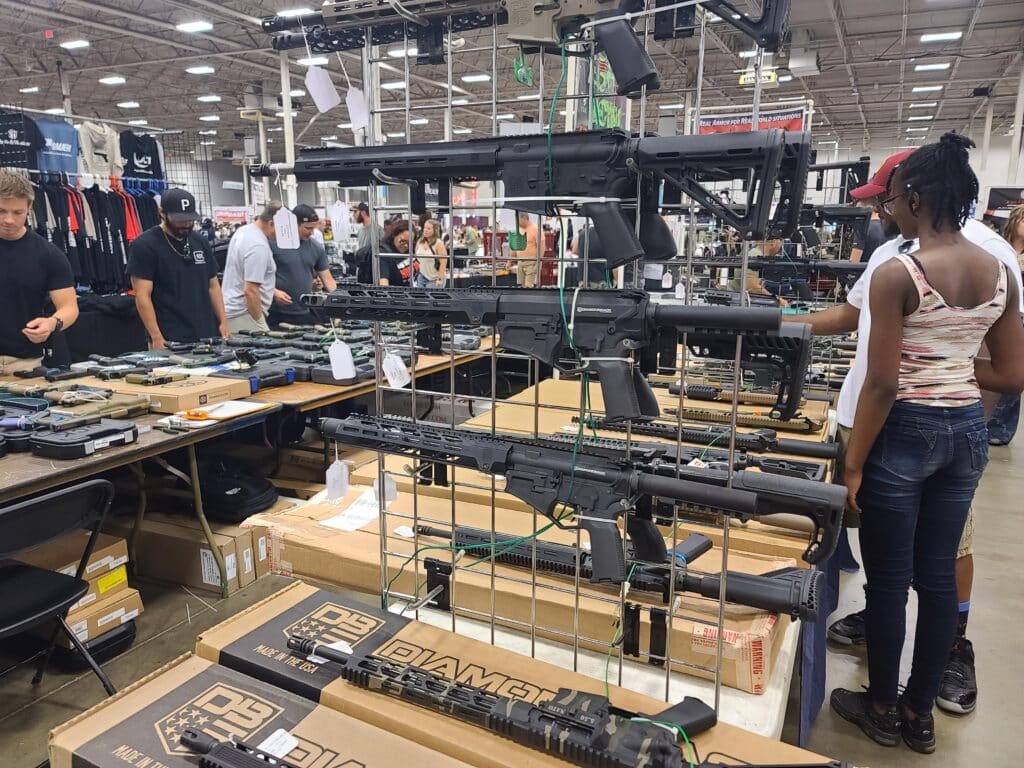We just got one of the strangest post-Bruen rulings.
In New Jersey, a federal judge struck down the state’s ban on AR-15s. But only on AR-15s. He didn’t address the other guns banned under the “assault weapons” ban and he upheld the magazine capacity limits. Contributing Writer Jake Fogleman examines the unique reasoning in the case.
A New York judge also denied an attempt to place a government monitor over the NRA this week while barring Wayne LaPierre from reclaiming an official role at the group for the next decade. However, the case isn’t over yet, and major reforms are still on the table. I explain why the NRA’s fate has yet to be decided.
Plus, we answer your questions on the podcast!

Analysis: A New Twist in Hardware Ban Litigation [Member Exclusive]
By Jake Fogleman
Can AR-15s be “commonly used” arms afforded protection by the Second Amendment while the magazines that usually come with them are not? At least one federal judge seems to think so.
Last Tuesday, US District Judge Peter Sheridan struck down New Jersey’s ban on AR-15s (and only AR-15s) as unconstitutional under the Second Amendment. At the same time, he ruled that the state’s related prohibition on ammunition magazines capable of holding more than ten rounds was on solid legal footing.
“The AR-15 Provision of the Assault Firearms Law is unconstitutional under Bruen and Heller as to the Colt AR-15 for use of self-defense within the home,” Judge Sheridan wrote in Cheeseman v. Platkin. “In contrast, the LCM Amendment is constitutional under these same decisions.”
Even among the disparate outcomes reached by judges grappling with the Supreme Court’s new Second Amendment test over the last two years, Judge Sheridan’s reasoning stands out. Most lower courts evaluating “assault weapon” and magazine bans to this point have treated them as nearly one and the same—either by striking each down or, more commonly, upholding both. Judge Sheridan’s treatment of New Jersey’s similar bans uniquely splits the difference.
First, his analysis held AR-15s as distinct from every other class of semi-automatic firearm implicated by New Jersey’s sales ban. He justified that decision by arguing that the court was not as fully briefed on the other classes of affected firearms.
“[T]he information presented to the Court focuses largely on one specific type of firearm: the AR-15,” he wrote. “And given the variety of firearms regulated in the Assault Firearms Law and the nuances that each individual firearm presents, the Court’s analysis of the Assault Firearms Law is limited to the firearm with which the Court has been provided the most information: the AR-15.”
However, with that narrowed scope, he did apply the precedents established in Heller and Bruen in a way most gun-rights advocates would view as faithful. In determining whether AR-15s are “arms” protected by the plain text of the Second Amendment, Judge Sheridan rejected a reading of the “in common use” test defenders of AR-15 bans and judges who have upheld them alike have coalesced around.
“As is relevant here, the State Defendants appear to ask the Court to use a common use standard that grafts (1) common use with (2) a lawful purpose along with (3) evidence of the total number of self-defense incidents involving the relevant firearm in question,” he wrote. “This requirement, however, does not appear to have a threshold number that Plaintiffs must meet to show that a weapon is in common use for self-defense.”
Instead, he noted that there are currently tens of millions of AR-15s in civilian circulation, that the rifle has characteristics that make it “well-suited” to self-defense, and that there is evidence of its use in several recent “high-profile self-defense events.” He found that was enough to meet the burden of demonstrating that the rifle is “commonly used for a lawful purpose.”
“Following the guidance set forth in Heller and reiterated in Bruen, the plain text of the Second Amendment covers the individual conduct at issue here,” he concluded.
Judge Sheridan even suggested that this fact alone made subjecting the ban to a historical inquiry unnecessary since he said a total prohibition on a firearm clearing the common use test automatically fell outside of the nation’s historical tradition of gun regulation.
“Like in Heller, the Assault Firearms Law’s AR-15 Provision acts effectively as the total prohibition on a commonly used firearm for self-defense—AR-15s—within the home; the text of New Jersey’s Assault Firearms Law prohibiting a list of sixty-six weapons, including the Colt AR-15 defined in the AR-15 Provision,” he wrote. “The AR-15 Provision is impermissible under the plain text of Heller.”
When he turned to the magazine analysis, however, Judge Sheridan took a different tact. While he accepted the Third Circuit’s precedent that magazines are considered “arms” under the Second Amendment and that “large capacity magazines are commonly owned,” he did not stop his inquiry there under Heller as he did with AR-15s. Instead, he turned to New Jersey’s justification for its regulation “by examining its reasons for regulating large capacity ammunition magazines and their consistency with our Nation’s historical tradition of firearm regulation.”
He justified this distinction by stating that New Jersey’s categorical ban on AR-15s is facially similar to Washington DC’s categorical ban on handguns the Court struck down in Heller, but not facially similar to its categorical ban on magazines capable of holding more than ten rounds (that often come standard with AR-15s).
Rather, the more “nuanced analysis” alluded to by Justice Thomas in his Bruen opinion—one that courts that have upheld hardware bans almost universally appeal to—was instead called for in Judge Sheridan’s view. He argued that the modern problem of mass shootings allowed him to undertake a broader interpretation of historical weapons laws and concluded that mid-19th-century Bowie knife restrictions fit the bill as an appropriate analogue for the magazine ban.
“Once Bowie knives’ potential misuse became apparent, restrictions were enacted in all other states or territories–with the exception of New Hampshire–within the next few decades and up until the Twentieth Century,” Sheridan wrote.
Despite acknowledging that “few states prohibited the complete sale of Bowie knives” and instead mostly limited public carry or sales to minors, he said such restrictions formed the basis for “a tradition of prohibiting a subset of arms that could be useful and had become common for self-defense yet nevertheless posed a threat to public safety.”
“Like these restrictions, the LCM Amendment is precisely that–a restriction responding to safety concerns present in our time,” he said.
Overall, Sheridan’s opinion is a mixed bag.
His AR-15 analysis suggests that the Supreme Court’s Second Amendment precedents are constraining enough to bind, at least somewhat, the discretion of judges personally sympathetic to gun-control measures. Sheridan prefaced his opinion by expressing his distaste for the Supreme Court’s approach to gun rights and his thinly veiled desire for restrictive policy options.
“It is hard to accept the Supreme Court’s pronouncements that certain firearms policy choices are ‘off the table’ when frequently, radical individuals possess and use these same firearms for evil purposes,” he wrote. “Even so, the Court’s decision today is dictated by one of the most elementary legal principles within our legal system: stare decisis. That is, where the Supreme Court has set forth the law of our Nation, as a lower court, I am bound to follow it. This principle-combined with the reckless inaction of our governmental leaders to address the mass shooting tragedy afflicting our Nation-necessitates the Court’s decision.”
It also suggests, however, that the Supreme Court has not been so binding as to completely restrict that discretion.
“In the past, legislators took action to prevent these societal problems with limitations as the State of New Jersey has done here,” Judge Sheridan wrote. “This burden on the people of New Jersey’s right to self-defense is comparable to that imposed by these historical laws. As such, these historical analogues provide the basis for the following conclusion: that the State may regulate the permissible capacity of the large capacity magazines.”
Interestingly, the opinion also provides further evidence of the Rahimi decision’s minimal impact on most Second Amendment challenges since the Supreme Court handed it down in June. Judge Sheridan referenced the decision only once, in a section solely dedicated to summarizing the Supreme Court’s recent Second Amendment decisions, and never referred to it again throughout his legal analysis. Justice Thomas’ concerns about the Rahimi majority’s alterations of the Bruen test do not yet appear to have come to pass.
Since Bruen, the Supreme Court has been reluctant to take up new hardware ban cases. Until that changes, the door will remain open for lower court opinions to head in different directions, even within the same opinion.
Podcast: We Answer Your Gun Politics Questions [Member Early Access]
By Stephen Gutowski
This week, we’re answering Reload Members’ questions on the podcast.
So much has happened in the last few weeks. The NRA’s corruption just reached its end stage. Although, there are still some potentially decisive decisions for the judge to make. The Democrats just swapped out Joe Biden for Kamala Harris. Then Harris’s campaign walked back her most aggressive gun policy position.
Contributing Writer Jake Fogleman and I got several questions on those fronts. Plus, a few on my time as a CNN contributor. We did our best to answer as many as we could.
You can listen to the show on your favorite podcasting app or by clicking here. Video of the episode is available on our YouTube channel. An auto-generated transcript is available here. Reload Members get access on Sunday, as always. Everyone else can listen on Monday.
Claim your free 30-day trial at this week’s sponsor The Dispatch here!
Contributing writer Jake Fogleman and I discuss the legal consequences the NRA could face now that the remedies phase of its trial has all but concluded. We also cover Kamala Harris’ latest flip flop on AR-15 confiscation as well as a federal judge’s recent decision to strike down New Jersey’s ban on the very same weapons. Finally, we discuss big new election spending pledges from the nation’s largest gun control groups.

Analysis: The NRA’s Fate Isn’t Decided Yet [Member Exclusive]
By Stephen Gutowski
The judge in the NRA’s corruption case denied the New York Attorney General’s request for a court-appointed monitor to oversee the organization. But that isn’t the end of the story for the nation’s largest gun-rights group.
The NRA’s defeat of a monitor is the major takeaway. It was the primary remedy offered up by the AG. It was also the one endorsed by several dissident NRA board members.
However, that doesn’t mean the NRA got what it was arguing for either. For one, Judge Joel Cohen barred former CEO Wayne LaPierre from rejoining the group in an official capacity for at least a decade. But there’s good reason to think his order will extend further than that.
“In my view, the record showed not only misconduct by individual officers and employees but also failures by the board of directors and its committees to properly supervise the expenditure of the NRA’s charitable assets and to react quickly and decisively once questions about financial management arose, which really began as early as the 1990s, though more specifically and pointedly in 2018,” he said.
Still, Judge Cohen agreed that a court-appointed monitor would be too “heavy-handed” and could even infringe on the NRA’s First Amendment rights. He also seemed convinced the group had made real progress on internal reforms, including by appointing reformers and whistleblowers to key positions. However, he wasn’t convinced everything had yet been fixed.
“As to the NRA itself, the evidence presented at trial suggests that there remain vestiges of the regime that presided over the period of unlawful behavior that still do not recognize their role in failing to identify and rectify the wrongdoing,” Judge Cohen said on Monday, according to the court transcript. “While the NRA members recently flexed their democratic muscles to promote reform efforts, current NRA leadership continues to place decisive authority in the hands of those who did not take a strong hand against improper behavior and chose instead to close ranks behind a leader, despite ample evidence of extraordinary misconduct.”
That’s why, in addition to his ruling from the bench, Judge Cohen ordered the NRA and AG’s office to discuss a series of six different remedies he proposed and get back to him. What becomes of those reforms will determine a lot about the new direction of the NRA.
The changes he suggested don’t rise to the level of a monitor, but they are still significant. They would shrink the size of the NRA’s 76-member board and prevent insiders from keeping qualified candidates out of board elections. They would also add an in-house consult to help the group’s new Chief Compliance Officer, who would himself get added job protections to insulate him from internal pressure.
Like with LaPierre, his recommendations would keep those on the Audit Committee during the corruption at issue in the case off from leading it today.
“The overarching goal of the NRA’s course correction and this Court’s decision today is to establish a clear break from past practices that the jury determined violated New York law,” Judge Cohen said.
He made it fairly clear that these reform requests aren’t likely to be mere suggestions. He said he wanted to give each side a chance to discuss the reforms with each other and offer up potential revisions or objections, but he made it clear he believed they ought to be relatively uncontroversial since he said they are in the NRA’s interest. The end result may be something along the lines of a settlement or consent decree.
“Those are the types of remedies I have considered,” Judge Cohen said. “However, since this trial was really not focused on that and has focused almost entirely on the monitor remedy, I would like to give the parties an opportunity to discuss this, to consider it carefully, and any other ideas they might have for what I hope would be a consent order, but if not a consent order, their arguments back and forth on the various things that I’ve suggested or proposed or thought about.”
Judge Cohen appears to be looking for something of a third way in the fight between the NRA and the AG. He’s not convinced the problems are persistent and severe enough to justify “potentially speech-chilling governmental intrusion.”
“The notion that the NRA would simply lapse back into, in the absence of ongoing court supervision, a place where internal controls are routinely overridden by entrenched leaders immune from scrutiny by a compliant and equally entrenched board of directors, with executives and their families jetting off on private planes to lavish locales, seems wildly unrealistic,” he said. “Possible but not probable.”
Still, he thinks the NRA’s conduct was egregious and isn’t fully corrected.
“The NRA was slow to reform, despite warning signs as early as 2003,” he said. “There remain leaders on key board committees who, while they do seem smart and earnest, are difficult to disentangle from their role as overseers while long-running and blatant violations of NRA policy and New York law was rampant at the highest levels of the organization and who were also intimately involved, in some cases, in ill-considered and wasteful efforts to avoid accountability, including the disastrous decision to pursue bankruptcy to avoid accountability rather than simply righting the ship as best they could.”
While he’s giving each said the opportunity to work out the details of the reforms, he let them know he’d be the one to decide what to do with them.
“Ultimately, it will be up to me whether to order them and what to do, but I would like more precise guidance on the points that I’ve made,” Judge Cohen said.
The trial is over, but how these reform recommendations actually materialize will determine much of the path forward for the NRA.
That’s it for now.
I’ll talk to you all again soon.
Thanks,
Stephen Gutowski
Founder
The Reload







